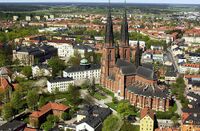Demographics of Glanodel
| Historical populations | ||
|---|---|---|
| Year | Pop. | ±% |
| 1900 | 1,998,509 | — |
| 1920 | 2,408,917 | +20.5% |
| 1940 | 3,075,087 | +27.7% |
| 1950 | 4,626,013 | +50.4% |
| 1960 | 6,908,536 | +49.3% |
| 1970 | 10,725,629 | +55.3% |
| 1980 | 11,092,915 | +3.4% |
| 1990 | 11,318,937 | +2.0% |
| 1995 | 12,059,456 | +6.5% |
| 2000 | 13,144,955 | +9.0% |
| 2005 | 13,668,374 | +4.0% |
| 2010 | 13,996,998 | +2.4% |
| 2015 | 14,377,667 | +2.7% |
| 2017 | 14,869,859 | +3.4% |
According to a 2017 estimate, the population of the Glanish Commonwealth is estimated at 14,869,859. It is the second most populous Lhedwin country, hosting almost one-third of the total population of the Lhedwin Isles. It's total population density is 62.92 per km2 (or 101.26 per sq. mi.). The cantons of Østbjorth, Særland, and Sørland are the most urbanized regions of the country, all located along the east coast bordering the Lhedwin Channel and the Asuran mainland, with most usable land developed. Graylund is the most populous city in Glanodel with 2.28 million residents (15% of the national population).
The population of Glanodel is considered a good example of a modern, transitioning demographic. This is generally characterized as typically pre-industrial populations experiencing low birth and mortality rates resulting in a slow, steady growth rate significantly impacted by immigration.
Glanodel's assumed literacy rate of 99% for citizens above the age of 15 is attributed to its aggressive public education system and its public subsidies for private education (both primary and secondary since the nation's re-establishment in 1900). Glanodel is also among the top 8 countries in the world with the highest percentage of populations with a tertiary degree. Although not officially a part of the Glanish government, the People's Church of Vænholm (Vænholm Folkekirke) was once the official church of the Glanish Kingdom prior to the establishment of the Commonwealth and was Trúathist. Today, the cathedral is used by a variety of faiths by numerous government and public officials for numerous events and ceremonies. Although Glanodel's religious demographic is fairly diverse when compared to other Asuran nations, Glanodel's dominant religion is still Trúathism.
Glanodel's population is predominantly White and of Asuran descent, with significant populations of Arabekian- and Cataian-Glens concentrated mostly along the east coast. The most frequently spoken language throughout all cantons is Glanish-Lhedwinic, with Newreyan and Midrasian being the two second most common. The majority of all Glanish residents educated in Glanodel are bilingual.
Population statistics
Metropolitan Areas
Largest cities in Glanodel
| ||||||||||
|---|---|---|---|---|---|---|---|---|---|---|
| Rank | Core City | Canton | Urban Population | Municipal Population | ||||||
| 1 | Graylund | Østbjorth | 1,738,287 | 2,286,984 | ||||||
| 2 | Broskov | Særland | 1,183,641 | 1,750,182 | ||||||
| 3 | Vænholm | Sørland | 1,064,682 | 1,601,484 | ||||||
| 4 | Allested | Feniland | 627,508 | 1,189,589 | ||||||
| 5 | Horne | Østbjorth | 399,999 | 753,902 | ||||||
| 6 | Dysted | Sørland | 358,757 | 609,886 | ||||||
| 7 | Dover | Hafland | 339,033 | 739,032 | ||||||
| 8 | Brosta | Sørland | 249,814 | 594,794 | ||||||
| 9 | Nordlunde | Østbjorth | 233,457 | 529,367 | ||||||
| 10 | Riserup | Særland | 230,483 | 523,419 | ||||||
| 11 | Gile | Hafland | 226,022 | 477,322 | ||||||
| 12 | Filholm | Siwald | 196,282 | 435,687 | ||||||
| 13 | Kyvling | Helloreg | 179,925 | 407,434 | ||||||
| 14 | Borsholm | Villradäl | 162,081 | 386,616 | ||||||
| 14 | Hennebjerg | Særland | 145,725 | 342,007 | ||||||
| Source: Statistics Glanodel (2015; Municipal data: 2014) | ||||||||||




